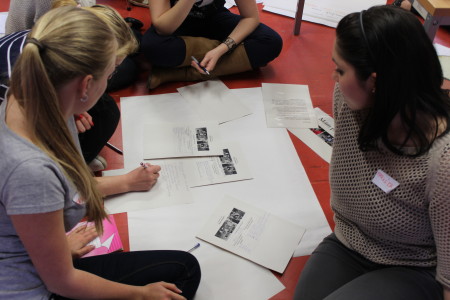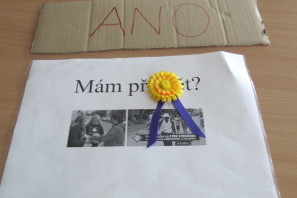I trialled this activity at our suburban Primary school of 450 pupils, in the Czech Republic. We focus primarily on ecological education; the school has its own science trail.
Choice of activity
I had little experience in evaluating the effects of teaching global topics. I trialled the activity Should I donate? with a Year 7 class (age 11 to 12) of 25 pupils (11 boys and 14 girls). There are several annual fundraising drives at the school; it thus seemed appropriate to explore the topic of helping others.
For the initial audit I used the activity as designed, wanting to hear pupils’ opinions on giving money to charitable collections. I expected them to be familiar with some charity events. Our school currently contributes to the education of an Indian boy and organises a charity run – I wanted to know if the pupils knew this.
Initial audit of the activity
I trialled the activity with 22 pupils present. The class decided the photographs represented charity, help to others, or collection of money for philanthropic purposes (14 pupils). Two said that they were adverts for a collection; one thought they represented a collection of money after some accident. All agreed the pictures were primarily about fundraising. The associations that the pupils most often made were help, charity and money; they also referred to donation, donor, disease or health, good, sadness or happiness. Other terms arising were fraud, poverty, homeless people and Africa. Some pupils struggled to come up with five associations that the pictures inspired, repeating classmates’ answers.
We then started on the main part of the activity. I explained the imaginary opinion scale where one side of the room represented I would donate and the other side I wouldn’t donate”. 11 pupils stood at the I would donate side, six in the middle and five on the I wouldn’t donate end.
In the ensuing discussion, pupils found it hard to pinpoint reasons for their decisions. Ambivalent pupils said It depends what it’s for but were unable to elaborate on this. Pupils who would donate suggested this was because their parents gave to charity. Only two pupils said that they would not donate because they did not have their own money. Eight pupils said they were afraid of fraudulent collections and that they did not get anything for giving money.
The audit showed that pupils would give to charitable collections because they wanted to help others (13 pupils), support research and education (eight pupils), or do something nice for others (three pupils). Some pupils felt that they did it to feel good about themselves (three pupils), or to give people hope (two pupils). Two pupils said they prefer animal charities. Pupils also felt that they could do something that could make a difference (bring happiness and hope). They also mentioned that if they did not do it, it would trouble their conscience.
The pupils had a positive reaction to the exercise. They remembered that one organisation helped through text messages, and that for example there was a flower campaign, etc., but they could not name a single organisation that helps people. Almost all talked exclusively about aid delivered in the Czech Republic.
For the second assessment I wanted pupils to think further about the meaning and possibilities of aid, get an overview of organisations providing aid, and be able to justify their opinions.
Teaching between audits
We discussed the possibilities of providing aid and the different activities that can contribute to this aim. I wanted the children to understand better how one can help. Concurrently, pupils had a chance to follow the countrywide Marigold Day campaign. The pupils on the one hand decided that collections and aid are needed, and on the other hand, complained that we were talking about charity again, feeling somewhat overloaded with this topic. They seemed however to have gained an overview of what aid can do and of the various fundraising campaigns.
Final audit of the activity
During the final audit, the (18) pupils were more confident, although pointing out that they had only recently completed the worksheets. They recognised that the photographs both showed fundraising campaigns for charity, differing in the way money is collected. They proved unwilling to give explanations for their five associations. I next incorporated a variation, asking pupils who would donate to take a step forward, and those who would not, to step back. 11 pupils stepped forward, two stepped back, and five remained where they were, much as initially.
This time, however, pupils used more emotional language: happiness, sadness, hope and good. Associations with money were not as central to their thinking. There were more references to the people who receive monetary aid, or the purpose that collections served, and fewer associations with diseases and disability. Overall pupils used a wider vocabulary. Even though pupils’ behaviour and opinions did not change, they were more engaged with the topic.
Those who said they wanted to help knew how to. They were often clearer about where they wanted to focus their efforts: I want to support research and education ; I want to help animals. Negative reactions were also better defined: pupils were even more afraid of fraudulent collections, feeling more secure with well-known charity drives. Other arguments remained constant: lack of money, getting nothing from helping others, not wanting to give to people they do not know, or wanting to keep their money.
Evaluating the activity
These pupils know a lot about local causes and collections and now also see the need for both local and international aid. They understand that they can contribute to helping others. If they do not help, it is because of their personal situation (I don’t have much myself).
I intend consulting teachers of Citizenship and Ethics to anchor the topic better within an appropriate context and timeframe, i.e. when big nationwide charity drives take place. If I repeated the activity, I would use different photographs for the final audit, probably omitting the T-graph. Between the audits I would invite a speaker from a charitable campaign, or someone who receives aid, to address the class.



